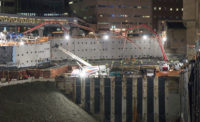Contractors, designers, health care providers and government agencies are working on multiple ways to speed delivery of hospital beds to care for COVID-19 patients. A wide range of solutions are being planned and deployed across the U.S., including fast-track fit-outs of existing spaces, temporary tents, mobile combat hospitals and modular solutions.
For ENR’s latest coverage of the impacts of the COVID-19 pandemic, click here
Plaza Construction and Central Consulting & Contracting are joining forces to offer fast-track services to health care providers in the northeast, the mid-Atlantic and Florida.
Brad Meltzer, president of Plaza Construction, said the team’s initial push has been to help fit out existing health care spaces, but it is also looking into converting non-traditional spaces, such as hotels or residential buildings, into temporary health facilities.
The effort is separate from the Army Corps of Engineers, which was given the mission by FEMA to build temporary hospital spaces. Read more on that effort here.
Converted Triage Space
Speed of delivery largely depends on existing infrastructure, such as medical gases, suction and the quality of HVAC systems, says Richard Simone, CEO and president of Central Consulting & Contracting.
Last week, his firm completed a project in New York City, where it converted triage space in a hospital’s existing emergency department into seven isolation rooms. Crews were able to complete the work in 23 hours, he says.
The firm also is converting three floors of an existing New York City hospital into an intensive care unit. Simone says the floors are nearly 9,000 sq ft each and can house 30 Intensive care unit rooms per floor. “The infrastructure is basically there and the HVAC is in good working order, so we will turn those three floors into an ICU in 30 days time,” he adds.
Meltzer says the firms are pursuing opportunities to convert other non-traditional spaces for patient overflow—such as cruise ships—but does not yet have projects.
The team is also pushing for modular solutions, working with FullStack Modular to create complete modular rooms inside shipping containers that could be used for triage, observation and isolation. “They can be clean, available, isolated, quickly deployed, have essential equipment and set up proximate to the hospitals,” says Roger Krulak, CEO of FullStack Modular. He says some clients are considering setting up camps of modules in surface parking lots adjacent to hospitals.
“Once we mobilize in a couple of weeks, we could get 200 to 300 units out per week,” Krulak says.
For now, the team says the fastest solution is for contractors to provide non-acute beds and other facilities, which require less infrastructure. The added non-acute capacity would allow health care facilities to free up existing beds for their more critical patients.
Going Modular
Krulak says modular ICU units can be produced, but they would take longer.
“For a second wave of facilities, we could provide an ICU solution, but it’s not something we can provide three weeks from now,” he adds. “The first wave of response is how to get heads in beds that are isolated so we can free up capacity in hospitals.”
EIR Healthcare also recently completed designs and plans for shipping container-based modular facilities. Grant Geiger, CEO and founder, says this week it introduced its 5-in-1 concept, which provides five negative pressure isolation rooms with one ante room that accesses each. He claims that crews can produce an average of 6 units per day. “For an order of 100 or more, it will take us about three to four weeks,” he says. “That’s the fastest solution and the easiest one to get going.”
Geiger also says clients are considering placing containers in parking lots or in adjacent fields. Small modular central utility plants can be added with the ability to service “seven or eight rooms per plant.”
The company also produces modular units that can be added to new or existing spaces, including ICU units. Although ICU rooms are more time consuming to create, he believes they can eventually be produced at the rate of five per day.
Maryland and Washington State Push
Mercy Medical Center is fast-tracking delivery of 32 acute care beds, fitting out a floor of existing shell space at the Mary Catherine Bunting Center in downtown Baltimore. The project was approved the day after Maryland Gov. Larry Hogan called for an increase in hospital beds in the state.
Contractor Whiting-Turner is providing short-term financing of the $12.5-million project, which allowed it to move forward immediately. The project is expected to take 75 days to deliver.
This week, King County in Washington state began construction of a “temporary recovery location” on a soccer field north of Seattle. The facility is a metal-frame tent that covers roughly half of the soccer field.
The county’s Dept. of Community and Human Services expects the temporary facility to house up to 200 beds for residents who have nowhere else to go while preserving local hospital beds for the most acutely ill in the community.
King County says it anticipates a need of up to 3,000 public health-supervised beds.
With Tim Newcomb




